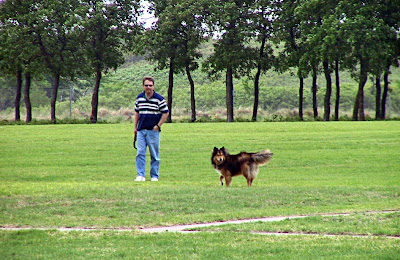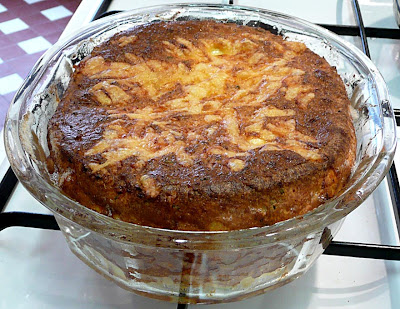I'm thinking about the poor people of Joplin, the tornado-devastated city in Missouri. I can't say I've ever been there — not really — but I did spend night once on the outskirts of the town. It was in May of 2003.
Walt and I were driving across the United States, from California to North Carolina via Champaign, Illinois, where we were going to visit old friends Harriett and Tom. We might have gotten farther that day, but for a truck accident up ahead of us on the highway between Oklahoma City and Tulsa. We had started out early from Tucumcari, New Mexico, that morning. I think our goal for the day might have been Springfield, Missouri. That's a trip of 650 miles — more than 1000 km.
 The interstate highway in Oklahoma went from this...
The interstate highway in Oklahoma went from this... ...to this, in the blink of an eye, and we didn't know why.
...to this, in the blink of an eye, and we didn't know why.
This is how I remember American traffic.
Anyway, after sitting in stopped traffic for an hour or more on I-44 in Oklahoma, we were exhausted. We didn't even know why traffic had come to a standstill. It was hot and the dog was restless — Collette was 11 years old then, and had never spent so many days in a row in the car. We had put her new kennel in the back of the Jeep. She didn't know it, but she was going to travel to France in that kennel a few weeks later, in the baggage hold of an airliner.
For weeks Collette had been treating the new kennel as if it were a prison cell, refusing to go near it, much less inside. But on the cross-country trip she curled up in it and slept tranquilly, starting on the second day on the road. It was comfortable — a refuge — and she had made peace with it. That was a relief for us, given the long, stressful trip she was going on.
Collette, unlike Callie, loved going for rides in the car, but that day in Oklahoma she didn't enjoy sitting in a car that wasn't moving. She wanted to go outside and sniff around, but we couldn't get out of the car. We didn't know when traffic might start moving again. We all had to pee, actually, but we were stuck in the traffic jam behind the wreck, and we weren't getting status reports.
 The State Capitol building in Oklahoma City
The State Capitol building in Oklahoma CityAnyway, we finally made it as far as Joplin MO and called it a day. We found a room in a motel that accepted dogs in the rooms. It was a Motel 6. We stayed mostly in Motel 6s as we crossed the country, because of the establishments' dog-friendly policies. Motel 6 is part of the Accor hotel chain. That's a French operation, and you know how dogs are not just tolerated but welcomed at most French restaurants and hotels. At Motel 6 too, and that's exceptional in the U.S.

 Walt and Collette at a rest stop in Oklahoma, May 2003
Walt and Collette at a rest stop in Oklahoma, May 2003Speaking of restaurants, we were hungry. We needed to find a place for dinner, and the first one we came upon was a Ruby Tuesday, a typical American franchise restaurant. It was near the intersection of 32nd Street and Rangeline Road in Joplin. I wonder if it survived the tornado on Sunday. I know from looking at maps that Sunday's tornado caused great destruction along Rangeline Road.
It was May 2, a Friday night, when we were there in 2003 (I won't explain how I remember that — another long story). Friday night is "date night" in America, of course, and in a little Midwestern city like Joplin that was obviously a big deal. The restaurant was packed with young people on dates. They were all dressed up and obviously having a fun evening. Maybe it was prom weekend or something similar.
Walt and I locked Collette in the car out in the parking lot — no dogs allowed in restaurants in America, of course — and went in to see if we could get a table. We got one, and it seemed to be located squarely in the middle of a sea of tables occupied by couples or groups of spiffed-up, fresh-faced 20-year-olds, or even teenagers. We ordered barbecued ribs, or at least I did. I don't really remember what Walt ordered.
 By the time we got to Joplin, it was too dark to take photos.
By the time we got to Joplin, it was too dark to take photos.The thing that drew everybody's attention to us traveling codgers was the wine. We ordered a bottle. Red. We were coming from California, after all, where the wine flows freely... and, paradoxically, expensively. We were used to having that thick, slightly sweet, very alcoholic California red wine with our dinners. "A whole bottle?" the very young waitress asked, astonished.
Yes, I said. She had to go see if they had any bottles of red wine behind the bar, and what kind it might be. I don't remember what label it had on it, but she did eventually bring a bottle to the table. She had a lot of trouble figuring out how to use the corkscrew to open it. She was very nervous. By then, all heads had turned and everybody in the place was watching these two old guys waiting to get their glasses filled and start drinking wine.
There was whispering. The crowd had never seen anybody open a bottle of wine before — much less drink one. At least that was my impression. Some of them were drinking beer, of course. But not vino. I didn't see any in glasses on any other table. There were smiles and amusement all around, mind you, not hostile or scandalized reactions, as we tasted the wine. Everybody was impressed, I think, in a good-natured Midwestern kind of way.
 Walt and his Jeep somewhere in Oklahoma in 2003
Walt and his Jeep somewhere in Oklahoma in 2003So that's my memory of Joplin, Missouri. That night, tornadoes were predicted to touch down nearby, and soon. We headed out early the next morning, driving toward St. Louis and beyond, into the wilds of the Illinois prairie. In Champaign that night, or maybe it was the next, there were strong thunderstorms with sharp lightning, but no tornadoes. Thankfully.
Back in southwestern Missouri, near Joplin, the May tornadoes were disastrous. I'm talking about 2003, not 2011. In Pierce City (pop. 1400), just 35 miles east of Joplin, a powerful tornado destroyed or damaged many structures in the town, including most of the buildings in the old downtown, which subsequently had to be torn down. Five people died. There's a
Wikipedia article about it.
Those tornadoes chased us all across Illinois and Indiana, into Kentucky, for the next few days. We saw funnel clouds in the sky as we drove south toward Tennessee, and listened to storm warnings and alerts on the radio. It rained so blindingly hard that we had to pull off the road at certain points and wait for it to let up. But we eventually made it to another Motel 6, this one in Pigeon Forge, Tennessee, still in a driving rain.
 The stormy weather and rain stayed mostly to the east and
The stormy weather and rain stayed mostly to the east and The ground is dry, but the reason why this grass under
The ground is dry, but the reason why this grass under
















































